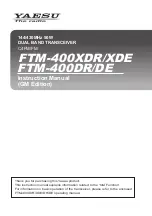RV-8 Service Manual
D10 and D13 diode networks prevent the large signals that come from phonograph needle dropping to
get into the mux circuitry on the analog board. C31, C38 and C45 for a third order high-pass circuit at
around 8Hz to block the low frequency rumble sounds. A tap is provided after the first opamp section.
This output is labeled 75uS_R/L because it does not include the 2122Hz / 75uS time constant rolloff filter,
which is useful to provide high frequency rich signals for click and pop detection algorithms.
Microphone Inputs
The circuitry here supplies power (9 volts) to an external microphone capsule, and performs balanced to
unbalanced conversion and amplification. The input op amp is protected from the common-mode
phantom power by 10uF input capacitors and an inductor-capacitor RFI filter network. This op amp is
unity gain and rejects common-mode noise from a differential microphone signal. The second op amp
amplifies the signal by 25.5dB. A diode network prevents microphone accidents from creating a large
signal that could clip the muxes on the analog board. A 100 ohm resistor pair isolates the output from
reactive loads.
Microphone “Phantom” Power Supply
Power is pulled from the +15V supply and regulated down to 9 volts by a voltage regulator. Diode D8
prevents back-biasing the regulator when +15V is removed. An RC filter is created by 330 ohms and
10uF. The 2.2K resistors provide current limiting and define the input impedance that the microphone
sees at the input of the amplifier.
RV-8 TUNER BOARD THEORY
This section provides a detailed description of the design theory embodied in the RV-8 Tuner Board.
Each section of this document will discuss the theory of each functional subset of this board and will
reference a schematic sheet for each block. The schematic set being referenced is at a minimum revision
level of 1.
•
The RV-8 Tuner Board incorporates the following features:
•
AM Stereo decoding
•
Station identification via the front panel
•
Radio Data Stream decoding (RDS)
•
Inter-station noise muting
Overall Design Theory
The entire design of the Tuner Board fits on one schematic sheet. Each functional block is discussed
separately.
Antenna Input (J1)
The antenna connectors comprise separate inputs for AM and FM. The AM terminals are standard
thumbscrew types that will accept twin-lead cabling, such as found on the antenna included as an
accessory shipped with the RV-8. FM is brought into the tuner via a 75-ohm F-type connector. FM signals
may be provided to the tuner via cable television service, or with the use of a 75/300 ohm Balun
transformer and a Y-style twin-lead antenna. The signals are mixed down to a single path into the
UT1384 tuner module by inductor L1, which provides a low impedance path for AM signals, and C1,
which provides a low impedance path for FM signals. The entry point into the tuner module acts as a
6-48
Summary of Contents for RV-8
Page 8: ......
Page 18: ...RV 8 Service Manual 3 6 ...
Page 54: ......
Page 76: ......
Page 132: ......
Page 156: ......
Page 157: ......
Page 158: ......
Page 159: ......
Page 160: ......
Page 161: ......
Page 162: ......
Page 163: ......
Page 164: ......
Page 165: ......
Page 166: ......
Page 167: ......
Page 168: ......
Page 169: ......
Page 170: ......
Page 171: ......
Page 172: ......
Page 173: ......
Page 174: ......
Page 175: ......
Page 176: ......
Page 177: ......
Page 178: ......
Page 179: ......
Page 180: ......
Page 181: ......
Page 182: ......
Page 183: ......
Page 184: ......
Page 185: ......
Page 246: ......
Page 247: ......


















